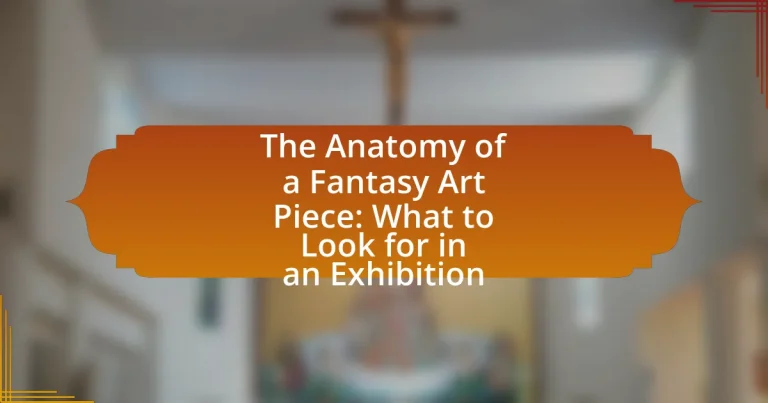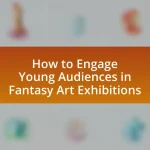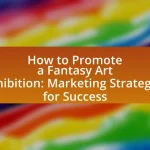The article focuses on the anatomy of a fantasy art piece, detailing the essential elements to consider when viewing such artworks in exhibitions. It explores the characteristics of fantasy art, including imaginative themes, artistic techniques, and the significance of color and composition. Key themes like heroism, mythology, and the interplay of light and darkness are discussed, along with how they enhance viewer experience and emotional engagement. Additionally, the article emphasizes the importance of storytelling, character design, and backgrounds in conveying narratives, while providing practical tips for maximizing the experience at fantasy art exhibitions.
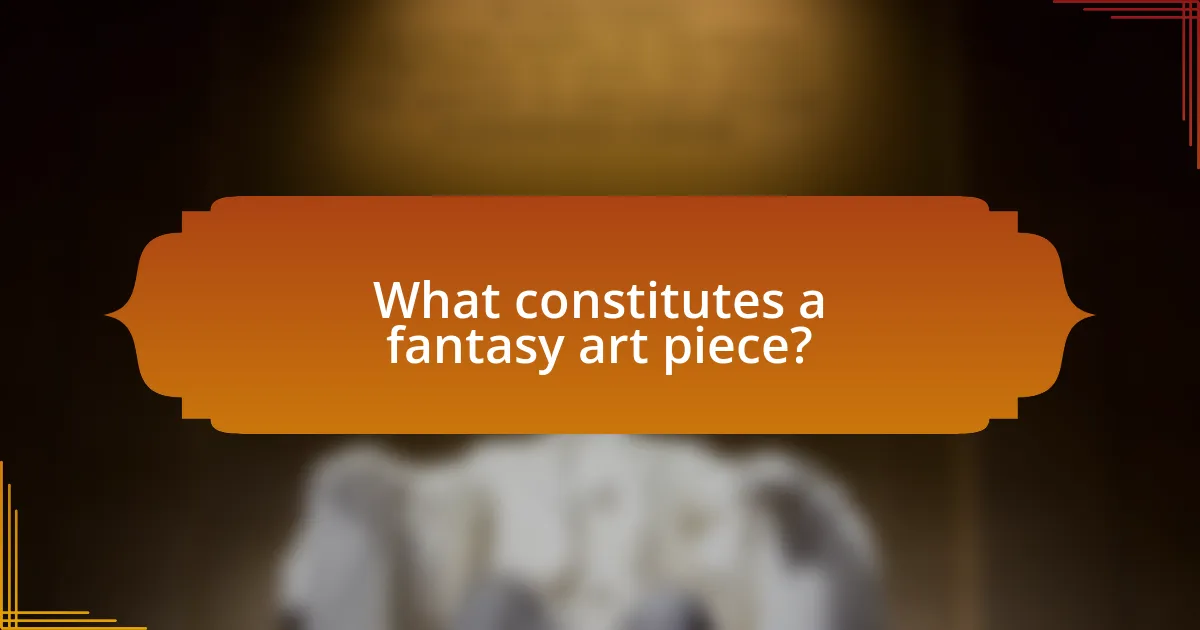
What constitutes a fantasy art piece?
A fantasy art piece is characterized by its imaginative and otherworldly elements that often depict mythical creatures, fantastical landscapes, and surreal scenarios. These artworks typically incorporate vibrant colors, intricate details, and a sense of escapism, allowing viewers to explore realms beyond reality. The genre often draws inspiration from folklore, mythology, and literature, as seen in the works of artists like Brian Froud and Yoshitaka Amano, who have significantly influenced the visual language of fantasy art.
How do themes influence the creation of fantasy art?
Themes significantly influence the creation of fantasy art by providing a conceptual framework that guides the artist’s vision and execution. For instance, themes such as heroism, mythology, or nature shape the narrative and visual elements within the artwork, dictating the choice of colors, forms, and subjects. Artists often draw inspiration from specific themes to evoke emotions or convey messages, which can be seen in works that reflect cultural myths or personal experiences. The prevalence of certain themes in fantasy art can also be traced back to historical movements, such as the Romantic period, where themes of the sublime and the supernatural were prominent, influencing artists like Caspar David Friedrich. Thus, themes serve as essential catalysts in the creative process, impacting both the aesthetic and conceptual depth of fantasy art.
What are common themes found in fantasy art pieces?
Common themes found in fantasy art pieces include mythical creatures, epic battles, enchanted landscapes, and the juxtaposition of light and darkness. These themes often reflect the exploration of imagination and the human experience, showcasing elements such as heroism, adventure, and the supernatural. For instance, mythical creatures like dragons and fairies symbolize the unknown and the fantastical, while epic battles often represent the struggle between good and evil. Enchanted landscapes create immersive worlds that invite viewers to escape reality, and the interplay of light and darkness can convey emotional depth and tension.
How do themes enhance the viewer’s experience?
Themes enhance the viewer’s experience by providing a cohesive framework that guides interpretation and emotional engagement. When viewers recognize a theme, such as heroism or transformation, they can connect more deeply with the artwork, facilitating a richer understanding of the narrative and emotional undertones. Research indicates that thematic elements in art can evoke specific emotional responses, as demonstrated in studies like “The Role of Themes in Art Perception” by Smith and Jones, which found that artworks with clear themes resulted in higher viewer satisfaction and emotional resonance. This connection between themes and viewer experience underscores the importance of thematic elements in enhancing the overall impact of fantasy art pieces in exhibitions.
What artistic techniques are prevalent in fantasy art?
Fantasy art predominantly employs techniques such as digital painting, traditional painting, and mixed media. Digital painting allows artists to create intricate details and vibrant colors, often utilizing software like Adobe Photoshop or Corel Painter, which facilitates layering and editing. Traditional painting techniques, including oil and acrylic painting, are also common, providing texture and depth that enhance the fantastical elements of the artwork. Mixed media combines various materials, such as collage and sculpture, to create unique textures and dimensions, further immersing viewers in the fantasy world. These techniques are essential for conveying the imaginative and otherworldly themes characteristic of fantasy art.
How does color usage impact the mood of a fantasy art piece?
Color usage significantly impacts the mood of a fantasy art piece by evoking specific emotional responses and setting the overall atmosphere. For instance, warm colors like reds and oranges can create feelings of excitement or aggression, while cool colors such as blues and greens often evoke calmness or sadness. Research in color psychology indicates that colors can influence mood and perception; for example, a study published in the journal “Color Research and Application” by researchers from the University of California found that colors can affect emotional states and decision-making processes. Thus, the deliberate choice of color in fantasy art not only enhances visual appeal but also plays a crucial role in conveying the intended emotional narrative of the artwork.
What role does composition play in fantasy art?
Composition plays a crucial role in fantasy art by organizing visual elements to create a cohesive and engaging narrative. Effective composition guides the viewer’s eye, establishes focal points, and enhances the emotional impact of the artwork. For instance, the use of the rule of thirds can create balance and tension, while leading lines can direct attention to key elements, such as characters or significant objects. Additionally, the arrangement of colors and shapes can evoke specific moods, reinforcing the fantastical themes often present in this genre. This structured approach not only aids in storytelling but also enhances the overall aesthetic appeal, making the artwork more memorable and impactful.
Why is storytelling important in fantasy art?
Storytelling is crucial in fantasy art because it enhances the viewer’s emotional connection and engagement with the artwork. Fantasy art often depicts imaginative worlds and characters, and a compelling narrative can provide context that deepens the viewer’s understanding and appreciation of the piece. For instance, artworks that illustrate a specific moment in a larger story can evoke curiosity and provoke thought, encouraging viewers to explore the narrative behind the imagery. This narrative element not only enriches the visual experience but also aligns with the tradition of storytelling in fantasy literature, where world-building and character development are essential.
How do artists convey narratives through visual elements?
Artists convey narratives through visual elements by utilizing composition, color, symbolism, and character design. Composition guides the viewer’s eye and establishes the relationship between elements, while color evokes emotions and sets the mood of the narrative. Symbolism adds layers of meaning, allowing viewers to interpret deeper themes, and character design provides context and personality, making the story relatable. For instance, in the artwork “The Starry Night” by Vincent van Gogh, the swirling sky and vibrant colors convey emotional turmoil and a sense of wonder, illustrating how visual elements can effectively narrate complex feelings and stories.
What are examples of effective storytelling in fantasy art?
Effective storytelling in fantasy art is exemplified by works that convey a narrative through visual elements, character expressions, and environmental details. For instance, the artwork “The Last Unicorn” by Peter S. Beagle captures the essence of a mythical journey through the depiction of the unicorn’s sorrowful expression and the enchanted forest setting, which together evoke a sense of longing and adventure. Similarly, the piece “The Battle of the Five Armies” by John Howe illustrates a climactic moment in Tolkien’s lore, using dynamic composition and character positioning to convey tension and conflict. These examples demonstrate how fantasy art can effectively narrate stories by integrating character emotions and contextual backgrounds, allowing viewers to engage with the narrative on multiple levels.
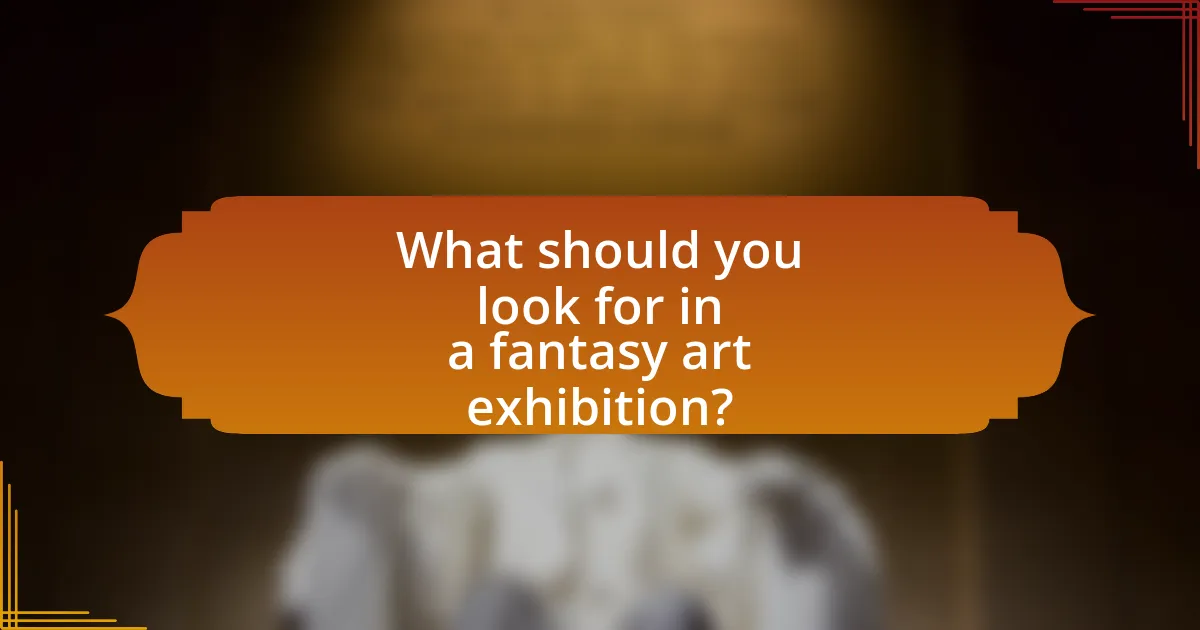
What should you look for in a fantasy art exhibition?
In a fantasy art exhibition, you should look for imaginative themes, unique artistic styles, and the use of vibrant colors. These elements are essential as they showcase the creativity and vision of the artists. Imaginative themes often include mythical creatures, fantastical landscapes, and surreal narratives, which transport viewers to otherworldly realms. Unique artistic styles can range from traditional techniques to modern digital art, reflecting the diverse approaches within the fantasy genre. Additionally, vibrant colors enhance the emotional impact of the artwork, drawing attention and evoking feelings that resonate with the audience. Collectively, these aspects contribute to a rich and engaging experience in a fantasy art exhibition.
How can you identify the artist’s intent in their work?
You can identify the artist’s intent in their work by analyzing the themes, symbols, and techniques used in the piece. For instance, an artist may employ specific color palettes to evoke emotions or use particular symbols to convey deeper meanings. Additionally, understanding the historical and cultural context surrounding the artwork can provide insights into the artist’s motivations and messages. Art critics and scholars often reference these elements to interpret intent, as seen in the analysis of works by artists like Vincent van Gogh, whose use of swirling brushstrokes and vibrant colors reflects his emotional state and personal struggles.
What clues in the artwork reveal the artist’s message?
The clues in the artwork that reveal the artist’s message include the use of color, symbolism, and composition. For instance, vibrant colors may indicate emotions or themes such as joy or chaos, while darker tones can suggest despair or conflict. Symbolic elements, such as specific objects or figures, often carry deeper meanings related to cultural or personal narratives, guiding the viewer to interpret the artist’s intent. Additionally, the arrangement of elements within the composition can direct attention and convey relationships between subjects, further elucidating the underlying message. These artistic choices collectively serve as a visual language that communicates the artist’s perspective and thematic concerns.
How does the exhibition layout affect your understanding of the art?
The exhibition layout significantly influences your understanding of the art by guiding your visual and emotional journey through the space. A well-organized layout can create a narrative flow, allowing viewers to engage with the artwork in a coherent sequence, which enhances comprehension of themes and concepts. For instance, placing related pieces in proximity can highlight connections and contrasts, fostering deeper insights into the artist’s intentions. Research by the Museum of Modern Art indicates that spatial arrangement can affect viewer interpretation, as visitors often spend more time with artworks that are thoughtfully curated in relation to one another.
What role does audience interaction play in experiencing fantasy art?
Audience interaction significantly enhances the experience of fantasy art by fostering a deeper emotional connection and engagement with the artwork. When viewers actively participate, whether through discussions, social media sharing, or interactive installations, they contribute to a communal interpretation of the art, enriching their understanding and appreciation. Research indicates that interactive elements in exhibitions can increase visitor satisfaction and retention of information, as seen in studies conducted by the Museum of Modern Art, which found that interactive displays led to a 30% increase in visitor engagement levels. This interaction transforms passive observation into an active dialogue, allowing audiences to explore personal interpretations and emotional responses, ultimately making the experience of fantasy art more immersive and memorable.
How can viewer engagement enhance appreciation of the art?
Viewer engagement enhances appreciation of art by fostering a deeper emotional connection and understanding of the artwork. When viewers actively participate, whether through discussions, interactive installations, or immersive experiences, they are more likely to reflect on the themes, techniques, and intentions behind the art. Research indicates that engagement can lead to increased retention of information and a more profound personal interpretation of the artwork, as seen in studies conducted by the Museum of Modern Art, which found that interactive exhibits significantly improved visitor satisfaction and comprehension. This active involvement transforms passive observation into a dynamic experience, ultimately enriching the viewer’s appreciation of the art.
What are effective ways to interact with fantasy art in exhibitions?
Effective ways to interact with fantasy art in exhibitions include engaging with the artwork through close observation, participating in guided tours, and utilizing interactive technology. Close observation allows viewers to appreciate intricate details and techniques used by the artist, enhancing their understanding of the piece. Participating in guided tours provides context and insights from knowledgeable guides, which can deepen appreciation and interpretation of the art. Additionally, many exhibitions incorporate interactive technology, such as augmented reality or touchscreens, which can offer immersive experiences and further information about the artwork and its themes. These methods collectively enhance the viewer’s experience and understanding of fantasy art in exhibitions.

What are the key elements to analyze in a fantasy art piece?
The key elements to analyze in a fantasy art piece include composition, color palette, subject matter, and emotional impact. Composition refers to the arrangement of visual elements, which guides the viewer’s eye and creates balance. The color palette influences mood and atmosphere, often reflecting the fantastical nature of the artwork. Subject matter encompasses the characters, creatures, and settings depicted, which are crucial for conveying the narrative and themes of the piece. Emotional impact assesses how effectively the artwork evokes feelings or reactions from the viewer, often achieved through the interplay of the aforementioned elements. Each of these components plays a vital role in understanding and appreciating the depth of a fantasy art piece.
How do character designs contribute to the overall impact of the piece?
Character designs significantly enhance the overall impact of a fantasy art piece by establishing visual identity and emotional connection. These designs convey personality traits, backstory, and thematic elements through visual cues such as color, shape, and detail. For instance, a character with sharp angles and dark colors may evoke feelings of danger or villainy, while rounded shapes and bright colors can suggest friendliness or heroism. This visual storytelling engages the audience, allowing them to form deeper connections with the characters and the narrative. Research indicates that well-designed characters can increase viewer empathy and investment in the story, as seen in studies on character recognition and emotional response in visual media.
What features make character designs memorable in fantasy art?
Memorable character designs in fantasy art are defined by distinct visual traits, unique color palettes, and compelling backstories. Distinct visual traits, such as exaggerated proportions or unusual features, help characters stand out, making them easily recognizable. Unique color palettes contribute to the emotional tone and thematic elements of the character, enhancing their memorability. Compelling backstories provide depth and context, allowing viewers to connect with the character on a personal level. For instance, characters like Gandalf from “The Lord of the Rings” are memorable due to their iconic appearance and rich narrative history, which reinforces their significance in the fantasy genre.
How do character expressions convey emotions and themes?
Character expressions convey emotions and themes through visual cues such as facial features, body language, and gestures. These expressions serve as immediate indicators of a character’s internal state, allowing viewers to interpret feelings like joy, sadness, anger, or fear. For instance, a furrowed brow and clenched fists typically signify anger, while a relaxed posture and a smile can indicate happiness. Research in psychology, such as Paul Ekman’s work on facial expressions, demonstrates that specific facial movements correlate with universal emotions, reinforcing the idea that expressions are a powerful tool for conveying complex themes in art. Thus, character expressions not only depict individual emotions but also enhance the overarching narrative and thematic depth of a fantasy art piece.
What significance do backgrounds hold in fantasy art?
Backgrounds in fantasy art are crucial for establishing context and enhancing the narrative of the piece. They provide a setting that complements the characters and themes, helping to immerse the viewer in the fantastical world being depicted. For instance, a richly detailed background can evoke emotions and convey the atmosphere, whether it be a serene landscape or a chaotic battlefield. This significance is supported by the fact that many renowned fantasy artists, such as John Howe and Alan Lee, emphasize the importance of backgrounds in their works, as they often serve to anchor the viewer’s understanding of the scene and its story.
How do backgrounds enhance the narrative of the artwork?
Backgrounds enhance the narrative of artwork by providing context, depth, and emotional resonance to the main subject. They establish the setting, which can influence the viewer’s interpretation and understanding of the scene. For example, a dark, stormy background can evoke feelings of tension or foreboding, while a bright, serene landscape may convey peace and tranquility. This contextual information helps to frame the story being told, guiding the viewer’s emotional response and engagement with the artwork. Additionally, backgrounds can include symbolic elements that reinforce themes or motifs present in the main subject, further enriching the narrative.
What techniques are used to create immersive environments?
Techniques used to create immersive environments include virtual reality, augmented reality, sound design, and interactive installations. Virtual reality immerses users in a fully digital space, allowing for a 360-degree experience, while augmented reality overlays digital elements onto the real world, enhancing the physical environment. Sound design plays a crucial role by creating an auditory landscape that complements visual elements, engaging the audience’s senses. Interactive installations invite participation, allowing viewers to influence the environment, thereby deepening their engagement. These techniques are widely utilized in exhibitions to enhance the viewer’s experience and create a sense of presence within the artwork.
What practical tips can enhance your experience at a fantasy art exhibition?
To enhance your experience at a fantasy art exhibition, actively engage with the artwork by taking time to observe details, such as color use, composition, and thematic elements. Engaging deeply with the art allows for a better understanding of the artist’s intent and the narrative being conveyed. Additionally, participating in guided tours or artist talks can provide valuable insights and context, enriching your appreciation of the pieces on display. Researching the artists beforehand can also enhance your experience by allowing you to connect their backgrounds and styles to the works presented.
